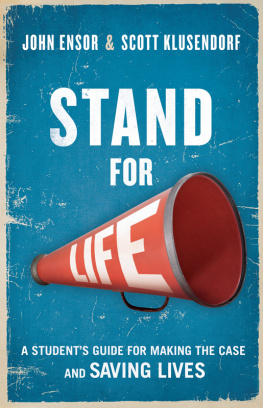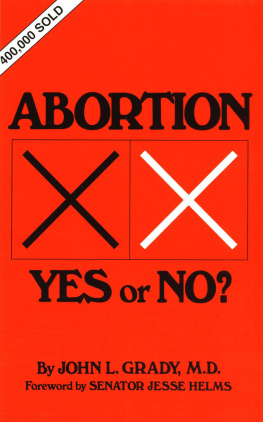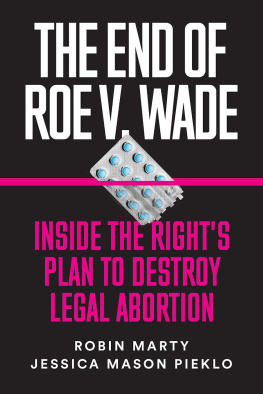UNSAFE ABORTION AND WOMENS HEALTH
Unsafe Abortion and Womens Health
Change and Liberalization
COLIN FRANCOME
Middlesex University, UK
First published 2015 by Ashgate Publishing
Published 2016 by Routledge
2 Park Square, Milton Park, Abingdon, Oxon OX14 4RN
711 Third Avenue, New York, NY 10017, USA
Routledge is an imprint of the Taylor & Francis Group, an informa business
Copyright Colin Francome 2015
Colin Francome has asserted his right under the Copyright, Designs and Patents Act, 1988, to be identified as the author of this work.
All rights reserved. No part of this book may be reprinted or reproduced or utilised in any form or by any electronic, mechanical, or other means, now known or hereafter invented, including photocopying and recording, or in any information storage or retrieval system, without permission in writing from the publishers.
Notice:
Product or corporate names may be trademarks or registered trademarks, and are used only for identification and explanation without intent to infringe.
British Library Cataloguing in Publication Data
A catalogue record for this book is available from the British Library
The Library of Congress has cataloged the printed edition as follows:
Francome, Colin.
Unsafe abortion and womens health : change and liberalization / by Colin Francome.
pages cm
Includes bibliographical references and index.
ISBN 978-1-4724-2761-8 (hardback) ISBN 978-1-3155-4896-8 (ebook)
ISBN 978-1-3170-0420-2 (epub) 1. Abortion. 2. Abortion Law and legislation. 3. Birth control. I. Title.
HQ767.F7198 2014
362.19888dc23
2013049432
ISBN 9781472427618 (hbk)
ISBN 9781315548968 (ebk-PDF)
ISBN 9781317004202 (ebk-ePUB)
Contents
List of Tables
Preface
In 2008 it was estimated that 47,000 women died of unsafe abortions which is one death in every eleven minutes.
Unsafe abortion is largely a problem of poverty. Most women in rich countries can obtain safe abortions locally and others can travel to countries where abortion is safe. In contrast, poor people have to face the vagaries of abortions occurring outside safe, legal health services. This leads to 99 per cent of abortion deaths occurring in poor countries.
Apart from the women who die there are numerous others who suffer illness.
There are those following religious doctrine who believe abstinence is the answer to unwanted pregnancies. However, country by country evidence provided in this book has yet to find a country where such a policy has proved effective.
Official figures suggest over four times as many women died from unsafe abortion as were killed in all the terrorist attacks around the world. Yet, while terrorism dominates the media and billions are spent hoping to prevent it, unsafe abortion remains the silent killer.
The evidence shows that the countries with the lowest rates of abortion are the Western European ones with legal operations backed up by good quality sex education and contraception.
The Guttmacher Institute reported that over 200 million women were sexually active, not wanting a pregnancy, yet not using contraception.
It is time to put womens health before religious dogma and to provide safe legal abortions worldwide.
Acknowledgements
Special thanks to Stan Henshaw of the Guttmacher Institute who wrote most of the US chapter, commented on the other chapters and provided the Appendix to .
Many others helped with this book. They include: Wendy Savage of Doctors for Free Choice on Abortion; Louise Bury of Marie Stopes International; Carla Francome; Martin Clough and Dr Marion Newman.
List of Abbreviations
|
|---|
AP | Associated Press |
BPAS | British Pregnancy Advisory Service |
CAWN | Central American Womens Network |
CEDAW | Committee on the Elimination of Discrimination against Women |
Can | Catholic News Agency |
COPUA | Coalition for the Prevention of Unsafe Abortion |
CRR | Centre for Reproductive Rights
International Campaign for Womens Rights to Safe
Abortion (sometimes ICWRSA) |
IJFP | International Journal of Family Planning |
IPPF | International Planned Parenthood Federation |
IRIN | Integrated Regional Information Networks |
MSI | Marie Stopes International |
MVA | Manual Vacuum Aspiration |
PI | Pathfinder International |
PRI | Population Research Institute |
WHO | World Health Organization |
WOW | Women on Waves |
Chapter 1
Introduction
Restrictive laws do not reduce the abortion rate they merely result in women dying
Dr Dorothy Shaw
Women in the richer countries of the world have access to safe abortions either in their own countries or as with Ireland, in a nearby country. In contrast, women in the developing countries face unsafe operations. We can be grateful for the fact that abortion deaths have declined somewhat. In 2008 there were an estimated 47,000 abortion deaths which is a reduction from the 2003 figure of 56,000. Hopefully the growth in availability of misoprostol and mifepristone will further reduce the figure. However, we can still agree with the comments from an article published by the World Health Organization (WHO) that Unsafe abortion remains one of the most neglected sexual and reproductive health problems (Grimes et al. 2006) This book aims to raise the importance of the issue and to propose measures to reduce the number of maternal deaths.
Latest figures indicate that nearly half the abortions in the world are unsafe and that nearly all (98 per cent) of unsafe abortions occur in the developing countries. In the developing world 56 per cent of abortions are unsafe compared with six per cent in the developed world (Guttmacher Institute 2013). The world figures showed a marked reduction in the incidence of abortions towards the beginning of the century. The number of abortions declined from 35 per 1,000 women of child bearing age in 1995 to 29 in 2003. However, by 2008 the rate had only fallen marginally to 28. The proportion of abortions that occur in the developing world increased between 19952008 from 78 per cent to 86 per cent. This was in part because the proportion of women living in the developing world increased. Consequently, while the number of abortions in the developed countries decreased by 600,000 between 20032008 in the developed world, they increased by 2.8 million in the developing world (Guttmacher Institute 2013). Apart from the women who die of abortion there are numerous others who suffer illness. The World Health Organization (WHO) estimates that around 2030 per cent of women having an unsafe abortion suffer reproductive tract infections. The result is that around two per cent of women become infertile due to unsafe abortion and five per cent suffer chronic infection (Grimes et al. 2006).










